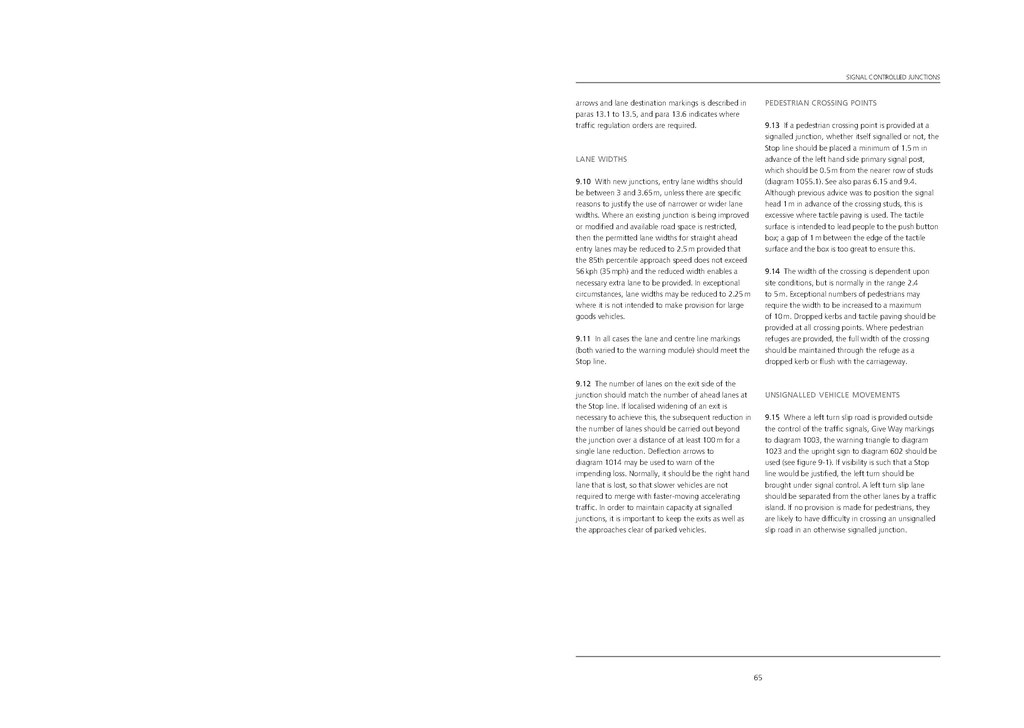arrows and lane destination markings is described in paras 13.1 to 13.5, and para 13.6 indicates where traffic regulation orders are required.
LANE WIDTHS
9.10 With new junctions, entry lane widths should be between 3 and 3.65 m, unless there are specific reasons to justify the use of narrower or wider lane widths. Where an existing junction is being improved or modified and available road space is restricted, then the permitted lane widths for straight ahead entry lanes may be reduced to 2.5 m provided that the 85th percentile approach speed does not exceed 56 kph (35 mph) and the reduced width enables a necessary extra lane to be provided. In exceptional circumstances, lane widths may be reduced to 2.25 m where it is not intended to make provision for large goods vehicles.
9.11 In all cases the lane and centre line markings (both varied to the warning module) should meet the Stop line.
9.12 The number of lanes on the exit side of the junction should match the number of ahead lanes at the Stop line. If localised widening of an exit is necessary to achieve this, the subsequent reduction in the number of lanes should be carried out beyond the junction over a distance of at least 100 m for a single lane reduction. Deflection arrows to diagram 1014 may be used to warn of the impending loss. Normally, it should be the right hand lane that is lost, so that slower vehicles are not required to merge with faster-moving accelerating traffic. In order to maintain capacity at signalled junctions, it is important to keep the exits as well as the approaches clear of parked vehicles.
9.13 If a pedestrian crossing point is provided at a signalled junction, whether itself signalled or not, the Stop line should be placed a minimum of 1.5 m in advance of the left hand side primary signal post, which should be 0.5 m from the nearer row of studs (diagram 1055.1). See also paras 6.15 and 9.4. Although previous advice was to position the signal head 1 m in advance of the crossing studs, this is excessive where tactile paving is used. The tactile surface is intended to lead people to the push button box; a gap of 1 m between the edge of the tactile surface and the box is too great to ensure this.
9.14 The width of the crossing is dependent upon site conditions, but is normally in the range 2.4 to 5 m. Exceptional numbers of pedestrians may require the width to be increased to a maximum of 10 m. Dropped kerbs and tactile paving should be provided at all crossing points. Where pedestrian refuges are provided, the full width of the crossing should be maintained through the refuge as a dropped kerb or flush with the carriageway.
UNSIGNALLED VEHICLE MOVEMENTS
9.15 Where a left turn slip road is provided outside the control of the traffic signals, Give Way markings to diagram 1003, the warning triangle to diagram 1023 and the upright sign to diagram 602 should be used (see figure 9-1). If visibility is such that a Stop line would be justified, the left turn should be brought under signal control. A left turn slip lane should be separated from the other lanes by a traffic island. If no provision is made for pedestrians, they are likely to have difficulty in crossing an unsignalled slip road in an otherwise signalled junction.
65
